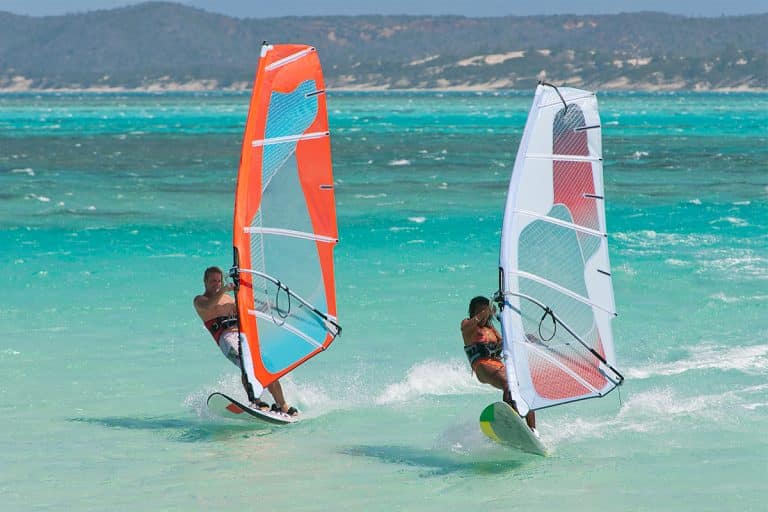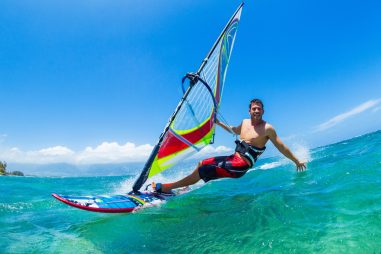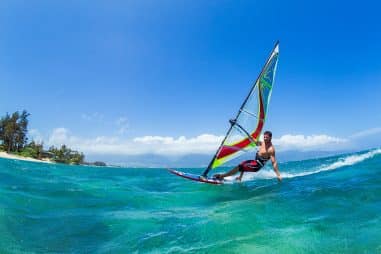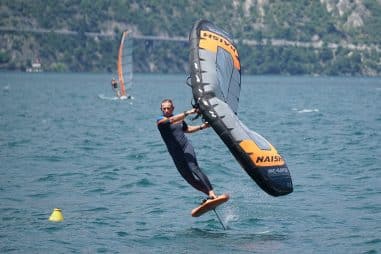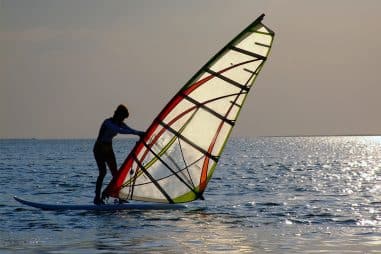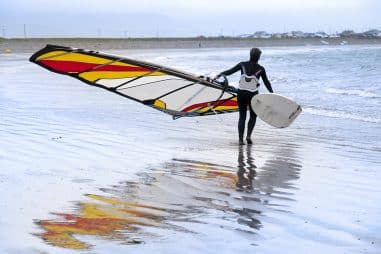Windsurfing and surfing almost have the same concept. Nevertheless, they are still nowhere close to being entirely the same even though they have quite a lot of similarities. If you are looking for a new sport or hobby to take up, it might be a great idea to try these three wonderful activities to help you make up your mind which of them you like best.
What Is the Difference Between Surfing and Windsurfing?
The main difference between the two is that surfing makes use of the wave’s power while windsurfing utilizes the wind’s energy to get up to speed. These two sports have a lot in common, but they also have a lot of differences that make them a sport of their own. Listed down below are some of their differences to help you distinguish them better from one another:
- Safety: The wave and wind are the two biggest factors that play a huge role in both sports as they both have a great impact on your riding experience. Although waves also change, it is easier to predict them since they tend to be more accurate whereas the wind changes a lot and it might unexpectedly alter direction, suddenly drop, or increase too much. With that said, a fun activity can easily turn into a dangerous one so you must always be prepared to come up with a plan if things go wrong and remember to never underestimate the risks that come with these two sports to keep yourself out of harm’s way.
- Cost: Surfing easily beats windsurfing when it comes to expenses. Surfing is certainly a lot cheaper than windsurfing because you can purchase a brand-new surfboard at around $750 and a secondhand board at approximately $300. On the other hand, windsurfing is way more expensive because you need more gear to get started with the sport such as sails, etc. which easily accumulates to a cost of roughly $3000 altogether.
- Learning: When it comes down to the speed of learning the sport, it highly depends on the ability of the person. Some will learn surfing faster than windsurfing because it is easier for them to catch waves while some will learn windsurfing faster than surfing because they can easily make use of the wind’s power. Having said that, you will have more successful attempts in windsurfing because it’s easier to balance whereas surfing will take you a couple of tries before you get it right.
- Training Accessibility: You will be able to practice and improve your skills depending on your location. If you live near the ocean, it is easier for you to train both surfing and windsurfing as long as the wind or the waves are present. If you live far from the ocean, you will probably have access to a lake or river near you which will allow you to spend more time on the water training wind sports such as windsurfing.
- Physical Fitness: Surfing is more physically challenging because it requires a much higher level of fitness than windsurfing. Windsurfing might seem difficult and tiring at first but once you get it dialed in, you will find it easier to make use of the wind to your favor. Surfing is more strenuous on the body as it requires you to paddle around which takes up a lot of energy.
- Durability of Equipment: Surprisingly, surfboards are made to be extremely light despite their big size because having a weighted board will require more energy to perfectly catch a wave. Since surfboards are lightweight, they are more fragile than windsurfing boards which makes them more vulnerable to breaking apart. Whether you have a windsurfing board or a surfing board, you must always be extra careful to avoid destroying your equipment.
- Number of Gear and Equipment: Surfing requires way less gear than windsurfing to begin in the sport. You will only need a board in surfing and you’re good to go while windsurfing requires a lot of other accessories apart from a board such as a sail, mast, boom, helmet, and many more. On top of that, it is significantly cheaper to maintain gear and equipment in surfing because the cost of repairs is less costly than windsurfing.
- Transportation: Transporting your surfing equipment is less inconvenient because windsurfing gear can be incredibly heavy and bulky. Apart from that, it’s also a bit of a hassle and quite expensive to move windsurfing equipment from one place to another. You have the option to try fitting it inside your car, but this is only achievable with ease if you’re traveling alone and have a lot of space in your vehicle.
- Weather Conditions: Several variables make up a good weather condition such as ocean weather, tidal conditions, wind power, wave power, and a lot more. The weather has a huge effect on both sports since windsurfing and surfing both use the power of either the wave or wind to create speed. Additionally, both windsurfing and surfing have different ideal weather conditions and accessibility to the two sports may vary widely depending on where you live.
- Thrill Factor: Windsurfing and surfing offer two completely different experiences even if their principle is almost the same. Looking for the right wave and where it will break is a lot of work in surfing. Many find chasing big waves extremely thrilling while others get a feeling of excitement from going incredibly fast by harnessing the wind’s energy just like in windsurfing.
Is Windsurfing Easier or Harder Than Surfing?
Surfing is more difficult than windsurfing because it takes a much higher level of physical fitness to continuously paddle about and catch waves for hours. It is a complicated sport that has a lot of elements in play such as the weather, wave energy, wind energy, surf conditions, line-up, and many more. It takes time to be good at surfing and it also demands a higher degree of endurance, strength, and stamina to be able to catch waves without having too much difficulty.
Although this may be the case, others might find windsurfing easier than surfing and vice versa. Some may easily pick up how to make use of the wind to their advantage while some may easily figure out how to maintain their balance on a surfboard when catching a wave. With that said, you must always keep in mind that it is still a very different experience for everyone as we all have different capabilities.
What Is Easier to Learn – Surfing or Windsurfing?
It’s a little tough to say if surfing is easier to learn than windsurfing because it’s a whole different experience for each person. Some people can learn surfing much easier than windsurfing because it is a lot easier for them to balance their weight on a surfboard and use the energy of the wave than to use the power of the wind caught in the sail. On the contrary, some people easily learn windsurfing than surfing since they find it easier to make use of the wind’s power, so everything is highly situational.
With that said, it is certainly undeniable that it takes a lot to be exceptionally good in both surfing and windsurfing. One must invest a great amount of time and effort practicing in the ocean to further improve their skills. These two wonderful sports have many challenges to offer and those who possess a high level of determination to enhance their technique will certainly be rewarded with not only a lot of fun but also a great sense of accomplishment.
Can You Surf on a Windsurf Board?
Surfing on a windsurf board is possible so long as you approach it with proper technique and execute body positioning the right way. Even so, you have to be mindful that catching waves using a windsurf board is a lot more challenging than using your conventional surfboard. After all, windsurf boards are made for windsurfing, and surfboards are made for surfing.
There are a few reasons why you can surf on a windsurf board. The main reason is that the foundational construction of both windsurf boards and surfboards are nearly identical which allows them to maintain speed and move their board around on the water. However, it is important to remember that windsurf boards are not made for this exact purpose so if you intend to catch waves very often, it is surely smart to invest in a good surfboard to get that maximum performance.
Can a Windsurfing Board Be Used as a Paddle Board?
It is possible to use a windsurfing board as a paddleboard, but you must bear in mind that not all windsurfing boards will do the job for you. It is crucially important to make sure that the windsurfing board you plan to use is buoyant enough to hold your weight up while you’re riding on it. If your windsurfing board does not have enough buoyancy to support your heaviness, there will be a high possibility of you sinking.
Just like mentioned earlier, it might be better to consider purchasing a reliable and good quality paddleboard if you want to do paddleboarding more frequently. It is undoubtedly worth the investment in the long run and you will also be able to paddleboard as you move through the water without having to constantly worry about the risk of being submerged underwater.
Can You Windsurf on a SUP?
Windsurfing on a SUP (Stand Up Paddleboard) is achievable but it is very important to know that some pros and cons come with it. Luckily, there are a lot of SUP companies that are also windsurfing companies which made it possible to windsurf using your SUP. The advancement of technology over the past couple of years gave birth to a wide selection of new products in the market that are highly versatile and durable.
Starboard is a company that made models that come with a windsurf option thereby making SUP windsurfing possible for those who want to try out both. They also have SUP Windsurfing sails that are particularly crafted for inflatable windsurfing and paddleboards that are not only lightweight but also strong. These extremely flexible and long-lasting products will provide you with lots of fun and a one-of-a-kind experience.

